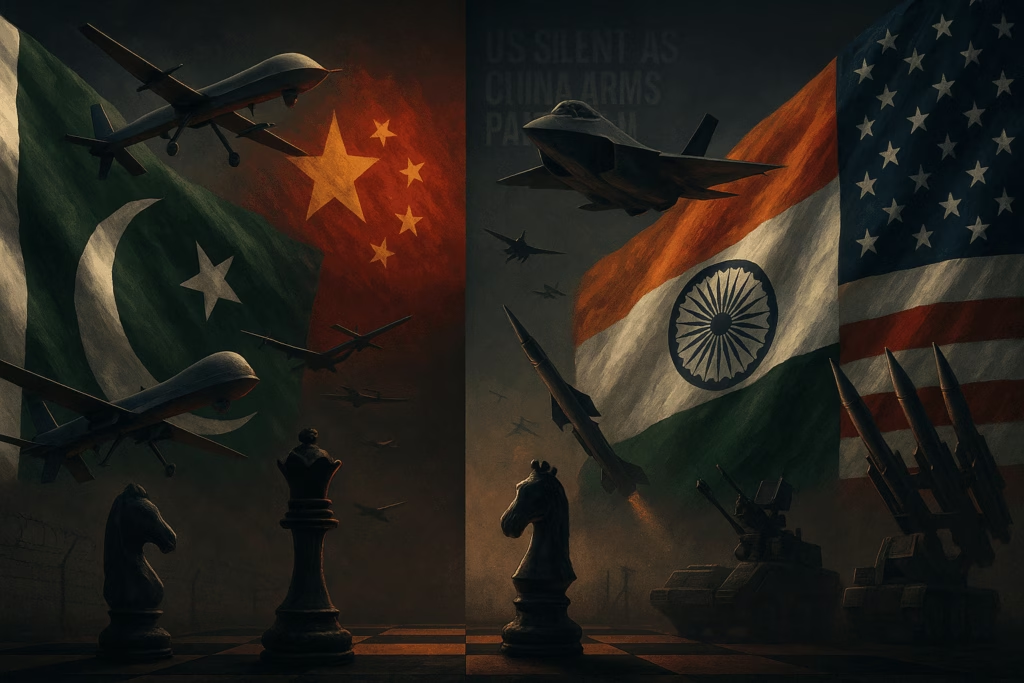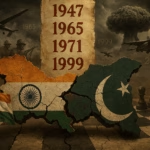Introduction: The Elephant in the Room
China Arms Pakistan for War, In January 2024, Pakistan’s military unveiled its new fleet of *J-10C fighter jets*—a $1.2 billion gift from China. Meanwhile, Washington issued no official statement. No sanctions. No condemnation. Just silence.
This isn’t an isolated incident. Over the past decade, China has supplied Pakistan with $14 billion in arms, including warships, drones, and missile systems. Yet the US, Pakistan’s Cold War-era ally, remains conspicuously mute. Why?
This article cracks open the geopolitical puzzle: Why is the US silent as China arms Pakistan for war?

The US Silence: Strategic Restraint or Strategic Blunder?
The Biden administration’s silence isn’t accidental—it’s calculated. Here’s the breakdown:
1. The China Containment Dilemma
The US sees China as its primary global rival. Countering Beijing’s rise requires focus on the Indo-Pacific, not South Asia. As former Pentagon official David Helvey noted, “We can’t afford to antagonize Pakistan while rallying allies against China.”
- Key Fact: The US relies on Pakistani airspace for counterterrorism ops in Afghanistan. Burning bridges risks losing critical access.
2. The India Factor
Washington’s growing partnership with India—a frontline state against China—complicates its stance. Publicly criticizing Pakistan’s militarization could strain ties with New Delhi, which views China arming Pakistan for war as an existential threat.
- Stat Quote:
“The US wants India to counter China but can’t ask Delhi to swallow a bitter pill publicly.”
— Alyssa Ayres, Council on Foreign Relations
3. Economic Entanglements
China holds $1.1 trillion of US debt. While not a direct lever, economic interdependence fosters cautious diplomacy. Sanctioning Pakistan could provoke Beijing into economic retaliation.
China’s Playbook: Why Arm Pakistan?
Beijing’s strategy isn’t just about India-Pakistan tensions—it’s about rewriting global power dynamics.
1. The “String of Pearls” Doctrine
China’s military investments in Pakistan (like Gwadar Port) secure trade routes and encircle India.
| China’s Key Assets in Pakistan |
|---|
| Gwadar Port (Indian Ocean access) |
| Karakoram Highway (trade to Middle East) |
| JF-17 Fighter Jet Co-Production |
2. Testing US Resolve
Flooding Pakistan with arms is a litmus test for American influence. By ignoring it, the US signals declining stakes in South Asia—a win for Beijing.
3. The Taiwan Parallel
Arming Pakistan distracts the US and India, freeing China to assert dominance over Taiwan. As scholar Yun Sun notes, “South Asia is a chessboard; Taiwan is the endgame.”
The Global Chessboard: Ripple Effects
1. Russia’s Silent Cheers
Moscow benefits from US-China friction. It recently sold Mi-35 helicopters to Pakistan while supplying India with S-400 systems—profiting from both sides.
2. Middle East Power Plays
Saudi Arabia and the UAE, traditional Pakistani allies, are shifting toward India. China’s arms deals help Islamabad retain Arab patronage.
3. Nuclear Nightmares
Pakistan’s expanding arsenal (165+ warheads) relies on Chinese tech. The US fears pressing too hard could push Islamabad toward reckless proliferation.
Voices from the Ground: A Pakistani Soldier’s Perspective
“These Chinese jets aren’t just machines—they’re a message to India and America,” says Major Ahmed (name changed), stationed near the Indian border. “Every radar system, every drone, tells the world we’re not alone.”
What’s Next? Three Scenarios
- Cold War 2.0 (Likely): US-China proxy conflicts in South Asia, with Pakistan as Beijing’s Cuba.
- Diplomatic Thaw (Unlikely): US brokers India-Pakistan talks to counter Chinese influence.
- Regional Arms Race (Already Happening): India boosts defense spending, triggering a $100B+ military surge across Asia.
Conclusion: The Silence Speaks Volumes
The US isn’t just silent—it’s trapped. Confronting China arming Pakistan for war risks losing India and destabilizing Asia. Ignoring it cedes ground to Beijing.
The world is watching: Will America’s next move be checkmate or stalemate?
Call to Action:
Want more insider analysis? [Subscribe for updates] or dive into our exposé on [How China’s Belt and Road Funds Global Conflicts].
Visual Elements:
- Infographic: “China’s Military Gifts to Pakistan (2015-2024)”
- Map: China’s “String of Pearls” bases encircling India.
- Table: US vs. China Arms Exports to Pakistan.
Internal Links:
- [How the US Lost Pakistan to China]
- [India’s $72B Defense Budget Breakdown]
External Links:
- [SIPRI Arms Transfer Database]
- [US State Department on China-Pakistan Ties]


